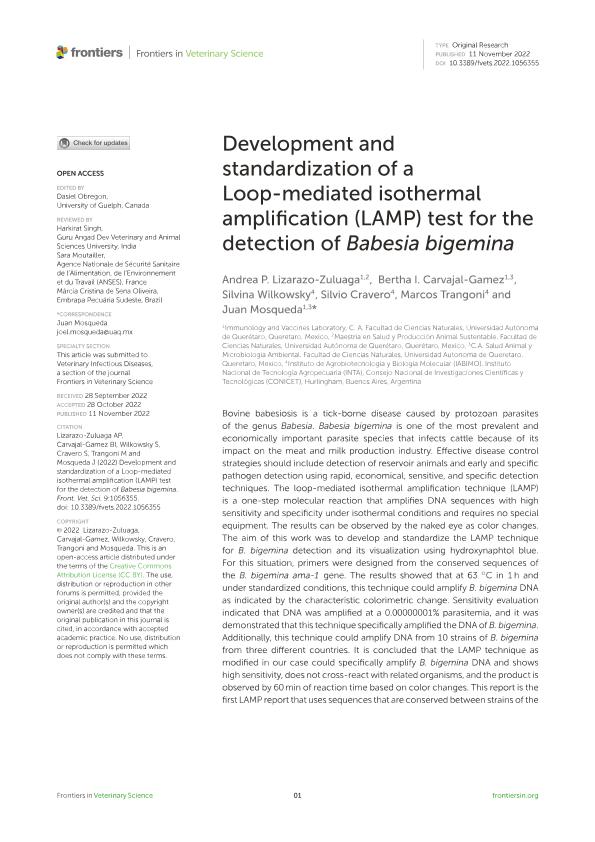Mostrar el registro sencillo del ítem
dc.contributor.author
Lizarazo Zuluaga, Andrea P.
dc.contributor.author
Carvajal Gamez, Bertha I.
dc.contributor.author
Wilkowsky, Silvina Elizabeth

dc.contributor.author
Cravero, Silvio Lorenzo Pedro

dc.contributor.author
Trangoni, Marcos David

dc.contributor.author
Mosqueda, Juan
dc.date.available
2023-09-28T17:56:17Z
dc.date.issued
2022-11
dc.identifier.citation
Lizarazo Zuluaga, Andrea P.; Carvajal Gamez, Bertha I.; Wilkowsky, Silvina Elizabeth; Cravero, Silvio Lorenzo Pedro; Trangoni, Marcos David; et al.; Development and standardization of a Loop-mediated isothermal amplification (LAMP) test for the detection of Babesia bigemina; Frontiers Media; Frontiers in Veterinary Science; 9; 11-2022; 1-10
dc.identifier.uri
http://hdl.handle.net/11336/213473
dc.description.abstract
Bovine babesiosis is a tick-borne disease caused by protozoan parasites of the genus Babesia. Babesia bigemina is one of the most prevalent and economically important parasite species that infects cattle because of its impact on the meat and milk production industry. Effective disease control strategies should include detection of reservoir animals and early and specific pathogen detection using rapid, economical, sensitive, and specific detection techniques. The loop-mediated isothermal amplification technique (LAMP) is a one-step molecular reaction that amplifies DNA sequences with high sensitivity and specificity under isothermal conditions and requires no special equipment. The results can be observed by the naked eye as color changes. The aim of this work was to develop and standardize the LAMP technique for B. bigemina detection and its visualization using hydroxynaphtol blue. For this situation, primers were designed from the conserved sequences of the B. bigemina ama-1 gene. The results showed that at 63 °C in 1 h and under standardized conditions, this technique could amplify B. bigemina DNA as indicated by the characteristic colorimetric change. Sensitivity evaluation indicated that DNA was amplified at a 0.00000001% parasitemia, and it was demonstrated that this technique specifically amplified the DNA of B. bigemina. Additionally, this technique could amplify DNA from 10 strains of B. bigemina from three different countries. It is concluded that the LAMP technique as modified in our case could specifically amplify B. bigemina DNA and shows high sensitivity, does not cross-react with related organisms, and the product is observed by 60 min of reaction time based on color changes. This report is the first LAMP report that uses sequences that are conserved between strains of the ama-1 gene, demonstrates the results by color changes using hydroxynaphtol blue. We propose LAMP as a rapid and economical alternative method for the molecular detection of B. bigemina.
dc.format
application/pdf
dc.language.iso
eng
dc.publisher
Frontiers Media

dc.rights
info:eu-repo/semantics/openAccess
dc.rights.uri
https://creativecommons.org/licenses/by/2.5/ar/
dc.subject
BABESIA BIGEMINA
dc.subject
DIAGNOSTICS
dc.subject
HYDROXYNAPHTOL BLUE
dc.subject
LAMP
dc.subject
MOLECULAR DETECTION
dc.subject.classification
Bioquímica y Biología Molecular

dc.subject.classification
Ciencias Biológicas

dc.subject.classification
CIENCIAS NATURALES Y EXACTAS

dc.title
Development and standardization of a Loop-mediated isothermal amplification (LAMP) test for the detection of Babesia bigemina
dc.type
info:eu-repo/semantics/article
dc.type
info:ar-repo/semantics/artículo
dc.type
info:eu-repo/semantics/publishedVersion
dc.date.updated
2023-07-08T00:33:55Z
dc.identifier.eissn
2297-1769
dc.journal.volume
9
dc.journal.pagination
1-10
dc.journal.pais
Suiza

dc.journal.ciudad
Lausana
dc.description.fil
Fil: Lizarazo Zuluaga, Andrea P.. Universidad Autonoma de Queretaro.; México
dc.description.fil
Fil: Carvajal Gamez, Bertha I.. Universidad Autonoma de Queretaro.; México
dc.description.fil
Fil: Wilkowsky, Silvina Elizabeth. Instituto Nacional de Tecnología Agropecuaria. Centro de Investigación en Ciencias Veterinarias y Agronómicas. Instituto de Agrobiotecnología y Biología Molecular. Consejo Nacional de Investigaciones Científicas y Técnicas. Oficina de Coordinación Administrativa Parque Centenario. Instituto de Agrobiotecnología y Biología Molecular; Argentina
dc.description.fil
Fil: Cravero, Silvio Lorenzo Pedro. Instituto Nacional de Tecnología Agropecuaria. Centro de Investigación en Ciencias Veterinarias y Agronómicas. Instituto de Agrobiotecnología y Biología Molecular. Consejo Nacional de Investigaciones Científicas y Técnicas. Oficina de Coordinación Administrativa Parque Centenario. Instituto de Agrobiotecnología y Biología Molecular; Argentina
dc.description.fil
Fil: Trangoni, Marcos David. Instituto Nacional de Tecnología Agropecuaria. Centro de Investigación en Ciencias Veterinarias y Agronómicas. Instituto de Agrobiotecnología y Biología Molecular. Consejo Nacional de Investigaciones Científicas y Técnicas. Oficina de Coordinación Administrativa Parque Centenario. Instituto de Agrobiotecnología y Biología Molecular; Argentina
dc.description.fil
Fil: Mosqueda, Juan. Universidad Autonoma de Queretaro.; México
dc.journal.title
Frontiers in Veterinary Science
dc.relation.alternativeid
info:eu-repo/semantics/altIdentifier/url/https://www.frontiersin.org/articles/10.3389/fvets.2022.1056355/full
dc.relation.alternativeid
info:eu-repo/semantics/altIdentifier/doi/http://dx.doi.org/10.3389/fvets.2022.1056355
Archivos asociados
